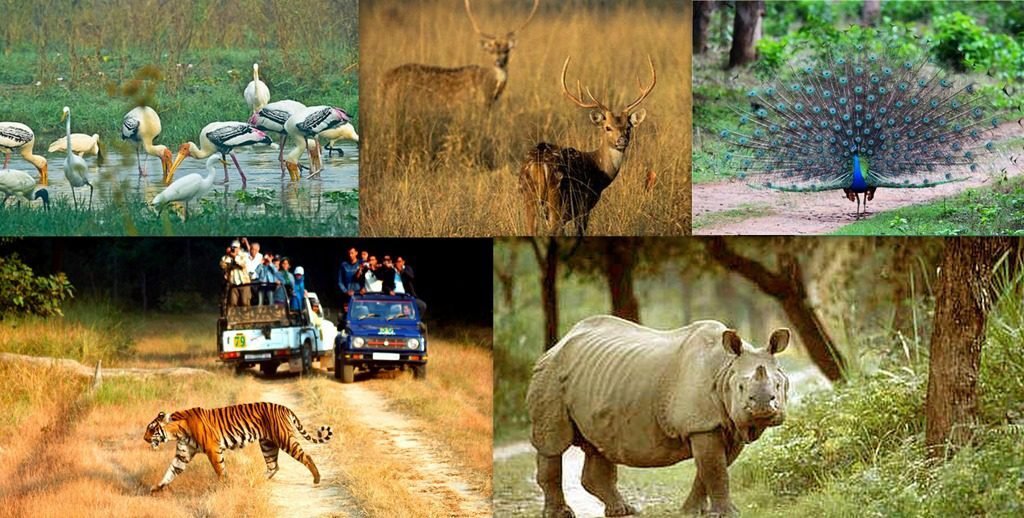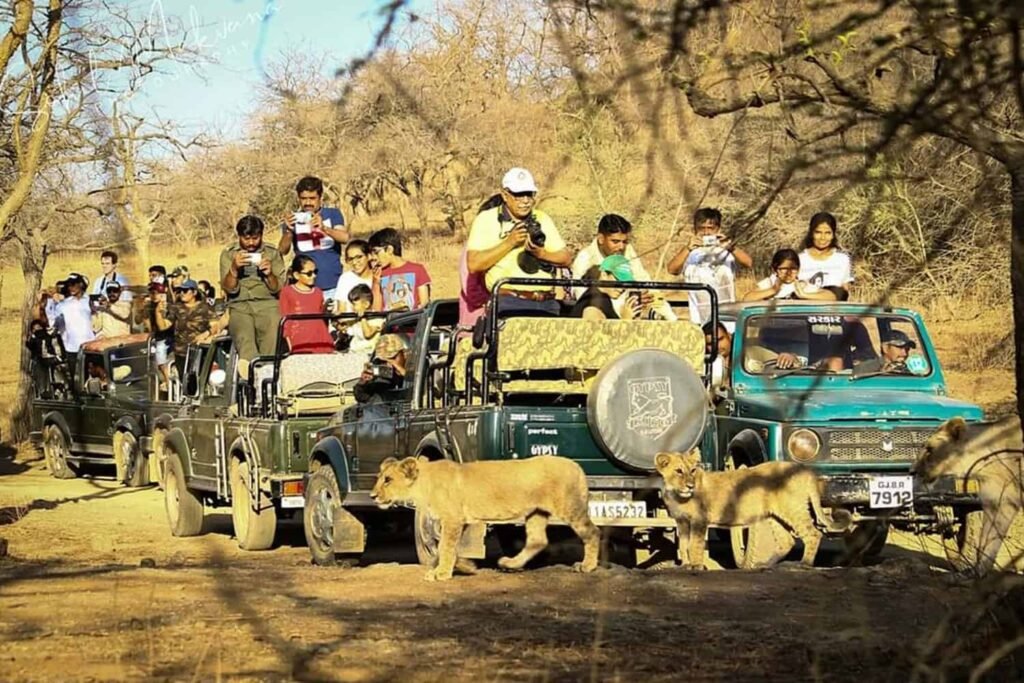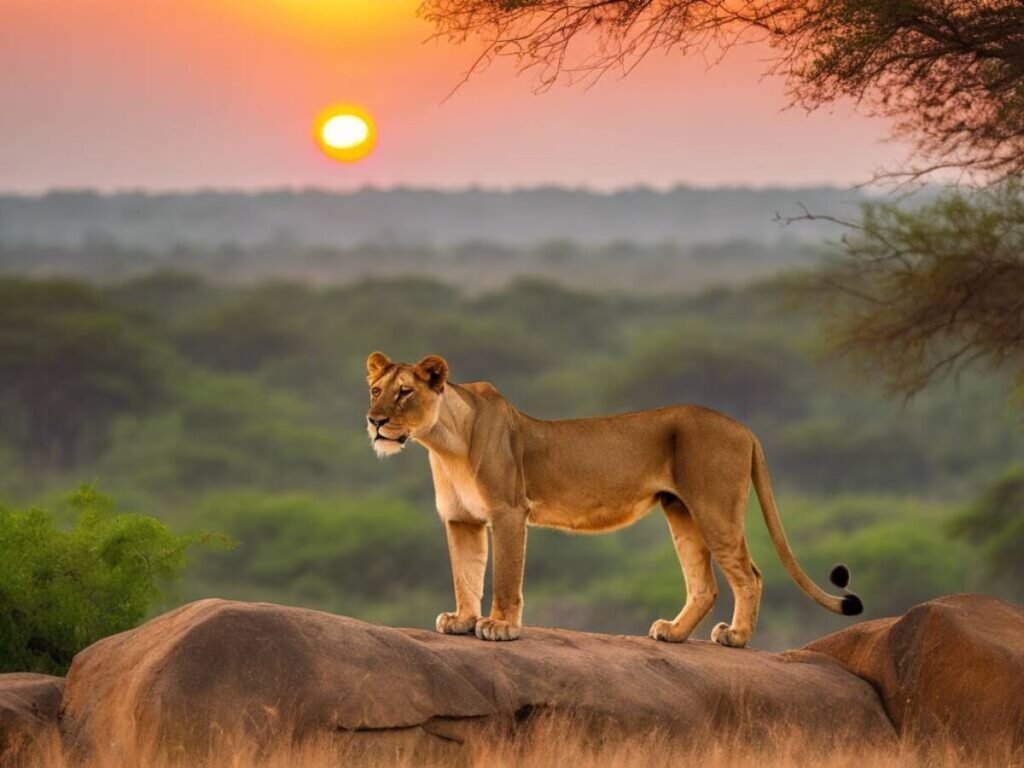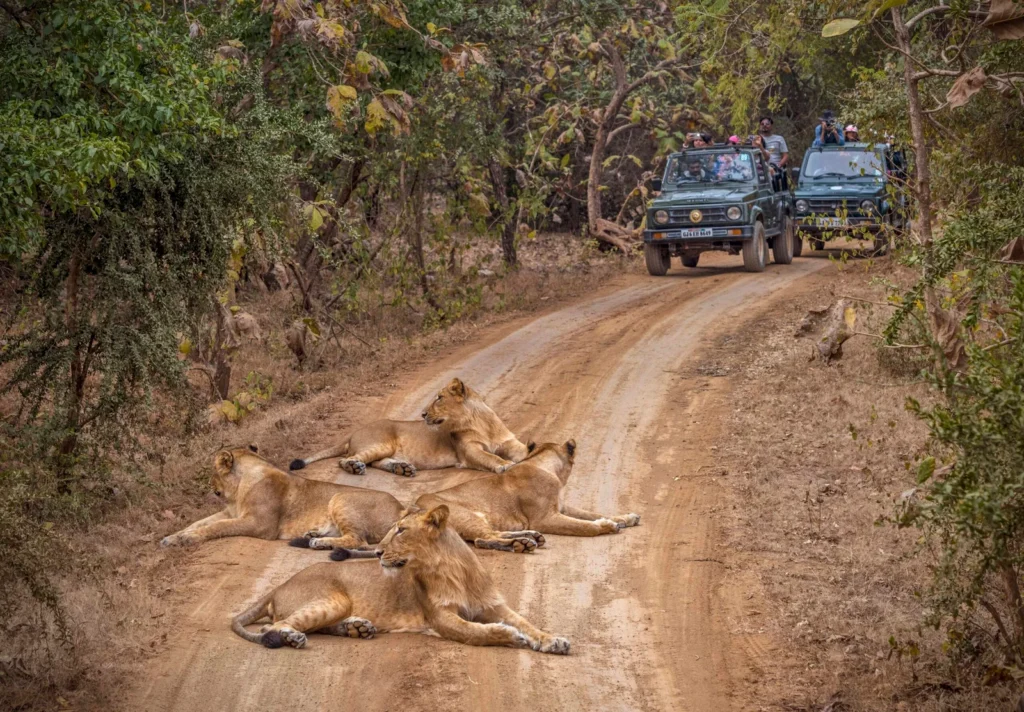
Welcome to Gujarat Top Blog! Today, we take you through Gir National Park, a sanctuary known for housing the rare Asiatic lions. Explore the unique wildlife and landscapes of this remarkable destination, which stands as a symbol of wildlife conservation in India.
A Safari Through the Wilds of Gujarat: Exploring Gir National Park.The sanctuary, located in the heart of Gujarat’s Saurashtra region, stands as a beacon of wildlife conservation. Known as the only habitat of the Asiatic lion (Panthera leo persica), this sanctuary is a must-visit for nature lovers, wildlife enthusiasts, and photographers alike. It’s a place where the wild roams freely, offering breathtaking views and once-in-a-lifetime experiences for those who venture into its lush wilderness.
In this post, we will take you through everything you need to know about The sanctuary — from its rich history and incredible wildlife to the best activities to experience in the park. We will also touch upon the park’s key conservation efforts and its role in preserving the Asiatic lion, a species that once faced the brink of extinction.
Table of Contents
The Gir National Park — An Overview
Gir National Park and Wildlife Sanctuary was established in the year 1965 and has a total area of 1,412 km. Besides Junagadh, the area is a mosaic of dry deciduous, thorny scrub and savanna grasslands that interspersed with perennial rivers such as Hiran and Saraswati. Originally established for the conservation of the decreasing number of Asiatic lions, the park also today symbolizes one of the successful examples in wildlife preservation.The sanctuary is home to the iconic Asiatic lions.
View More: Akshardham Temple
Asiatic Lions: Gir’s Pride
Asiatic lion is the star of Gir National Park. Asiatic lions are smaller, shaggier and have their own (belly) fold of skin that African lions do not have; they also lack the long flowing manes bore by most African lions. These lions once ranged across Asia but they declined to less than 20 animals at the start of the 20th century largely due to habitat destruction and hunting.
They now number more than 600 thanks to conservation efforts. Tourists frequently get to see these magnificent beasts in the wild while on an early morning or evening visit at Gir National Park.
Also View : Best Places To Visit In Gujarat

Gir National Park is home to a rich biodiversity
The Gir ecosystem is not just for lions. It houses a vast array of fauna that makes it an ecological hotspot.
- Mammals
Gir is home to nearly 40 species of mammals. Gir is the other major big cat habitat in addition to lions where leopards are frequently seen. Other species include:
- Indian wolves
- Striped hyenas
- Jackals
- Chital (spotted deer)
- Sambar
- Nilgai (blue bull)
- Wild boars
- Indian gazelles
Gir has herbivores that function as their prey base, maintaining a balance in the food chain.

2. Birds
Gir National Park is a paradise for bird watchers with more than 300 species of birds. Notable species include:
- Crested serpent eagles
- Indian eagle-owls
- Painted storks
- Flamingos
Another treat is the Kamleshwar Dam, which is dubbed as the lifeline of Gir that plays host to a lot of aquatic birds and offers stunning views.
3. Reptiles
Lizards All of the park also holds many reptiles for example:
- Marsh crocodiles
- Indian cobras
- Pythons
- Monitor lizards
These cold-blooded animals find ideal habitat in the water bodies of Gir.
Also View : Hanuman Chalisa Gujarati PDF
Flora of Gir National Park
Most of Gir comprises dry deciduous forest, filled with teak, acacia and dhok trees. The parks wide range of fauna are housed and fed in grasslands as well as thorny scrub. During hot summers the rivers and reservoirs within the park are life lines for flora and fauna communities.
Visitors flock to this sanctuary to witness the magnificent creatures in their natural habitat.

Best Time to Visit Gir National Park
The best time to visit Gir National Park is from October till mid-June with optimum wildlife activity from Octorber-March and ideal weather conditions.
- July to Sep — (Monsoon): During this time the park is closed because it is a breeding period for lions and other species.
- July to Sep — (Monsoon): During this time the park is closed because it is a breeding period for lions and other species.
Safari Experience Gir
Gir is all about medium-paced guided safaris that give you a peek at its wildlife.
- Safari Information: Each safari is for three hours minimum, in open gypsy vehicles with trained guides. They have morning and afternoon safaris too.
- Zones: The park is divided into woodlands safari zones to minimize human interaction within the core areas.
- Booking: Opt to book safaris through the Gujarat Forest Department by visiting their official website in advance.
- Lion are the special highlight of your safari, but you will likely also see leopard, deer and many different birds.

Conservation Efforts in Gir National Park
Indispensable Research on Natural History of the Asiatic Lion The revival of the Asiatic lion is one of the best conservation success stories in India. Key efforts include:
- Decreasing Poaching: The poaching rate has plummeted through tight patrolling and surveillance of conservation areas.
- Managed Waterholes and Grasslands: Well-maintained waterholes and grasslands mean a sustainable habitat for wildlife.
- Community Engagement: The Maldhari groups, who live in areas that serve as a buffer between the park and human settlements, have been central to protecting the area by reducing human-animal conflict.
- Movements to Other Sanctuaries: Some lions have been moved from Gir for preservation reasons; in a few instances, those movements were less than voluntary.

Nearby Attractions
Gir is a destination in itself, but here are a few attractions close to Gir that can be added to your itinerary:



How to Get To Gir National Park
The accessibility of Gir National Park is convenient through air, rail, and road:
- By Air: Diu (90 km) is the closest airport, Rajkot (160 km) and Ahmedabad (400 km) are major airports.
- By Rail: The nearest major railway stations from the tourist destination are Veraval (40 km) and Junagadh (65 km).
- By Road: The park is relatively easily reached from main cities such as an Ahmedabad, Rajkot via a state and private buses or taxi.
Also View : Dwarkadhish Temple
Why Visit Gir National Park?
- Adventurous experience and education-based fun along with conservation at Gir National Park. Besides the excitement of seeing Asiatic lions, the park is a unique destination due to its biodiversity, landscape and cultural importance.
- For wildlife lovers, nature photographers, and those looking to escape the grind of metropolitan life, Gir is a destination that creates lasting memories.
Map :
Gallery :








FAQs About Gir National Park
Gir National Park is known for providing home to which kind of animal?
Gujrat, India — Gir National Park is home to the iconic Asiatic lions. The region is also famous for its biodiversity hosting leopards, wild boars, deer, and a wide range of birds.
Which place is Gir National Park?
Gir National Park | Near Junagdh, Saurashtra Region of Gujarat, India About 1,412 square kilometres of land is devoted to the park and it devotes a larger area to Gir which is also proclaimed as the wildlife sanctuary.
What are the ways by which I can reach Gir National Park?
Air: Closest airport is Keshod Airport which is 50 km The fall back is Rajkot Airport which is 160 km away from the park.
By Train: The nearest railway station is Junagadh Junction which has connectivity to the major cities.
By Road:Gir can only be reached by road from a city such as Rajkot, Junagadh or even Ahmedabad.




